CHAPTER 8 – EMPLOYMENT AND SKILL DEVELOPMENT: TOWARDS QUALITY
As per the Periodic Labour Force Survey data, Indian labour market indicators have improved in the last six years, with the unemployment rate declining to 3.2 per cent in 2022-23. Rising youth and female workforce participation presents an opportunity to tap demographic and gender dividends. The Formal employment has grown, with net payroll additions under EPFO more than doubling in five years.
The job market must adapt to artificial intelligence, prioritizing collective welfare. Agro-processing and care economy are two promising areas for quality employment generation. Skilling efforts have progressed, but only 4.4% of the young workforce is formally skilled. Regulatory reforms, such as simplifying land use laws and promoting apprenticeships, can generate employment.
CURRENT EMPLOYMENT SCENARIO:
India has witnessed a notable transformation in the employment landscape due to several economic reforms, technological advancements, and an emphasis on skill development over a decade.
- The all-India annual unemployment rate has been witnessing a declining trend since the COVID-19 pandemic, with a rising labour force participation rate (LFPR) and worker-to-population ratio (WPR) as per the annual Periodic Labour Force Survey (PLFS).
- Employment has recovered from the pandemic in urban and rural areas, even by the relatively strict standards of current weekly status (CWS),
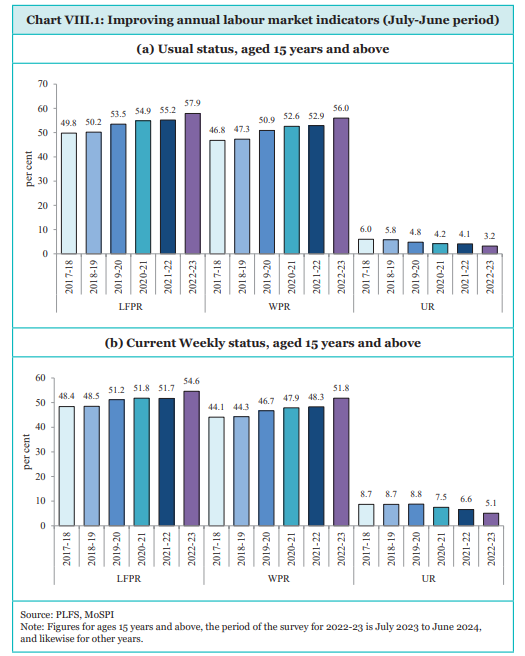
- The quarterly PLFS reports for urban areas enable a more updated picture of employment. The quarterly urban unemployment rate for people aged 15 years and above declined to 6.7 per cent in the quarter ending March 2024 from 6.8 per cent in the corresponding quarter of the previous year, accompanied by a rise in the WPR and LFPR.
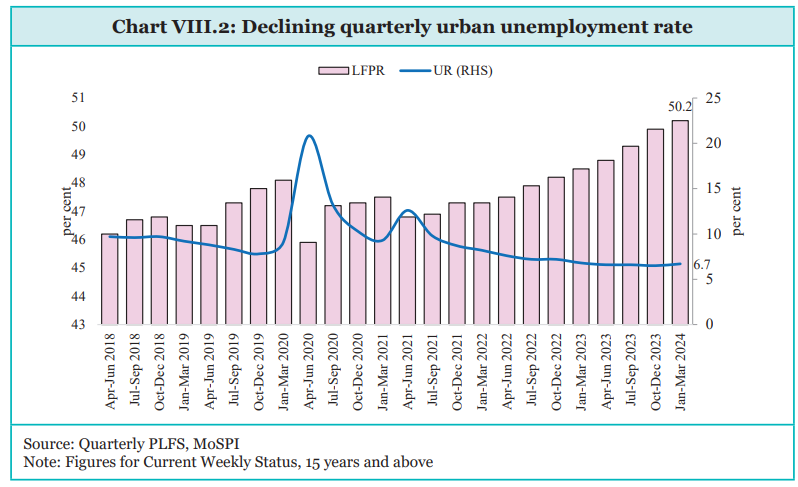
- India’s workforce is estimated to be nearly 56.5 crore in 2022-23 using WPR from PLFS and MoHFW’s population projections.
- According to PLFS, more than 45 per cent of the workforce is employed in agriculture, 11.4 per cent in manufacturing, 28.9 per cent in services, and 13.0 per cent is in construction.

- In terms of employment status of workers, 3 per cent of the total workforce is self-employed, and 18.3 per cent is working as unpaid workers in household enterprises. Casual labour comprises 21.8 per cent of the total workforce, and regular wage/salaried workers are 20.9 per cent of the total workforce.
- Gender-wise, the female workforce is shifting to self-employment, while the male workforce’s share has been stable.
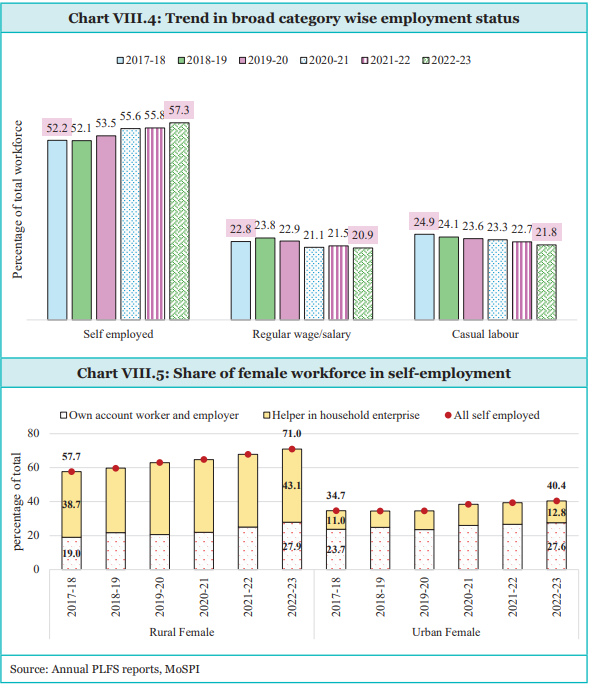
YOUTH AND FEMALE EMPLOYMENT
Rising youth employment
For India’s sustained high growth and global competitiveness in manufacturing and services, its demographic dividend is a stepping stone. The decline in the annual youth unemployment rate with greater youth participation in the labour force indicates better utilisation of this dynamic resource.
- The unemployment rate has declined from 17.8 per cent in 2017-18 to 10 per cent in 2022-23, as per the PLFS, with the improvement in several other indicators as well.
- Nearly two-thirds of the new subscribers in the EPFO payroll have been from the band that has been around for 18-28 years. Thus, youth employment has been rising in tandem with the youth population.
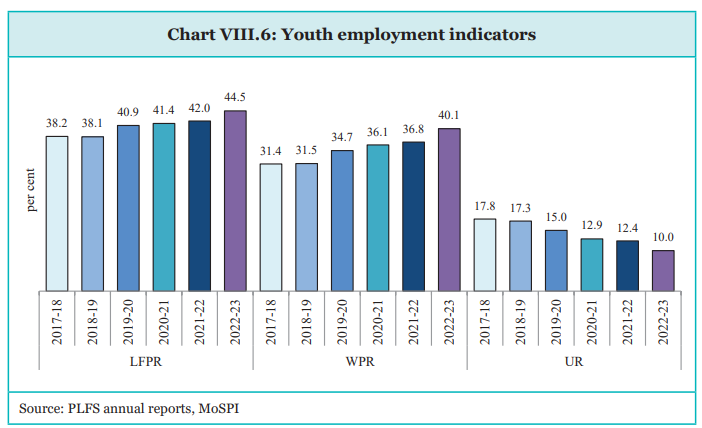
Rise in Female LFPR: Unfolding the gender dividend
Over the past six years, the female labour force participation rate (FLFPR) has. While urban FLFPR has also been growing, the rural FLFPR has witnessed a steep rise of 16.9 percentage points between 2017-18 and 2022-23, indicating a rising contribution of women to rural production.
This is because of various factors such as continuous high growth in agriculture output and freeing up of women’s time due to substantial expansion of access to basic amenities such as piped drinking water, clean cooking fuel, sanitation, etc.
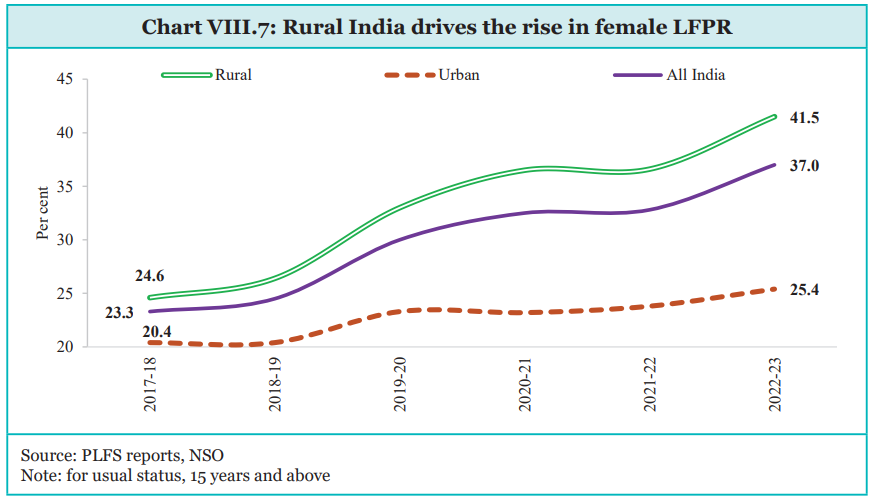
Employment in Factories:
- The Annual Survey of Industries results for 2020-21 and 2021-22 showcased the Indian manufacturing sector’s resilience, given its turnaround after a marginal fall in employment in the pandemic year of 2020-21.
- As per ASI 2021-22, employment in the organised manufacturing sector recovered to above the pre-pandemic level, with the employment per factory continuing its pre-pandemic rise.
- The growth in wages per worker resumed after a brief hiatus. This, coupled with higher wage growth in the rural areas during the last five years, bodes well for demand creation in the countryside.
- During FY15-FY22, the wages per worker in rural areas grew at 6.9 per cent CAGR vis-à-vis a corresponding 6.1 per cent CAGR in urban areas.
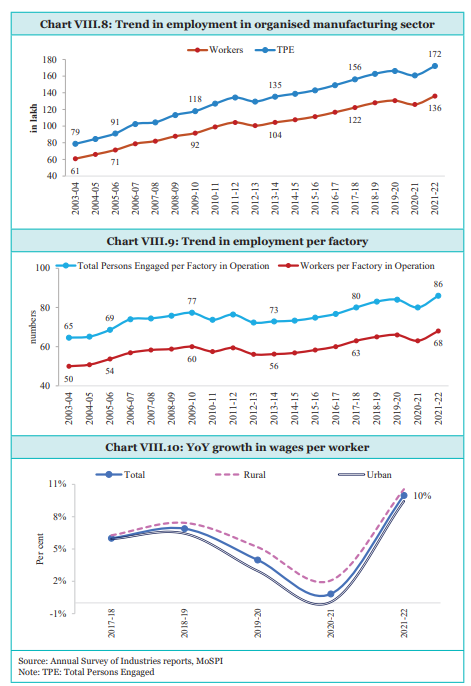
- State-wise, the top six states, in terms of the number of factories, were also the greatest factory employment creators. More than 40 per cent of factory employment was in Tamil Nadu, Gujarat, and Maharashtra.
- In contrast, from FY18 to FY22, the highest employment rate was seen in states with a higher share of the young population, including Chhattisgarh, Haryana, and Uttar Pradesh (Chart VIII.12).
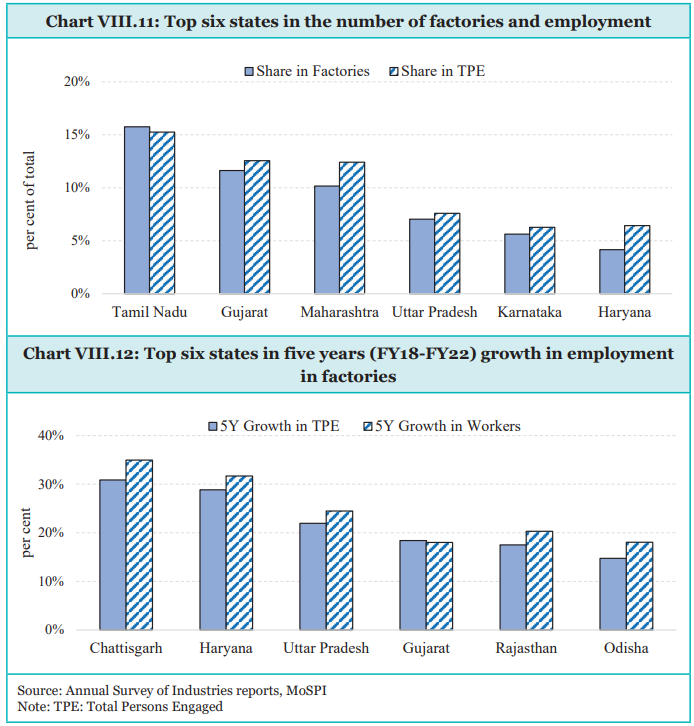
- In terms of the number of establishments, the organised manufacturing landscape is dominated by smaller factories. Smaller factories (less than 100 employees) dominate the sector, accounting for 79.2% of all factories in 2021-22. However, these smaller factories contribute only 22.1% of total employment and 20.9% of workers.
- There is a trend towards larger factories, with an 11.8% growth in factories employing over 100 workers from FY18 to FY22. Employment is rising faster in bigger factories, indicating a scaling up of manufacturing units. This shift towards larger factories is a positive development, as wages per worker tend to increase with factory size, improving the quality of employment.
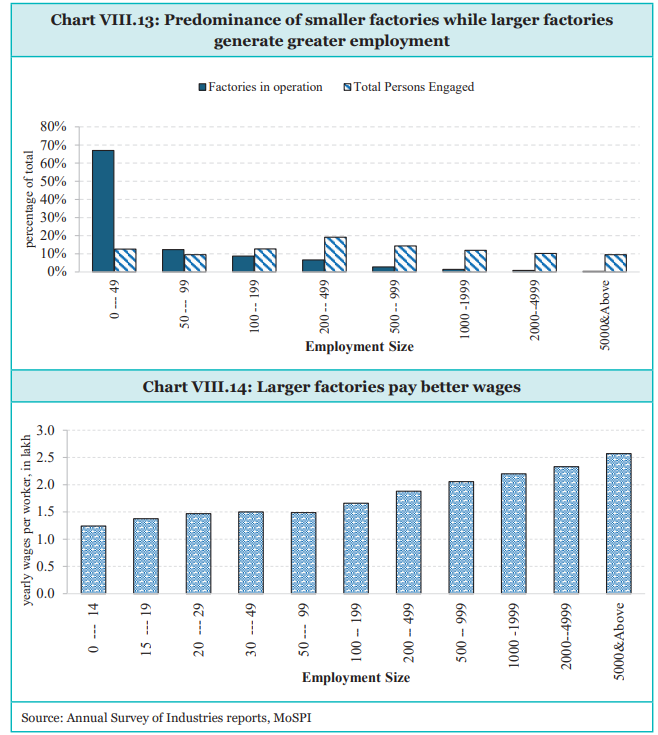
- In terms of the sectoral share of factory employment (total persons engaged),
- The food products industry is the largest employer, accounting for1% of factory employment.
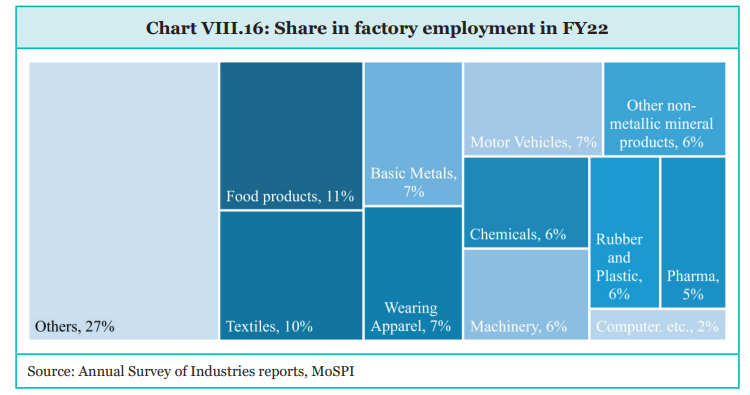
- In terms of growth in employment over the last five years, Computers and electronics, Rubber and plastic products and Chemicals have emerged as sunrise sectors, indicating a shift towards higher-value manufacturing and employment generation in these areas.
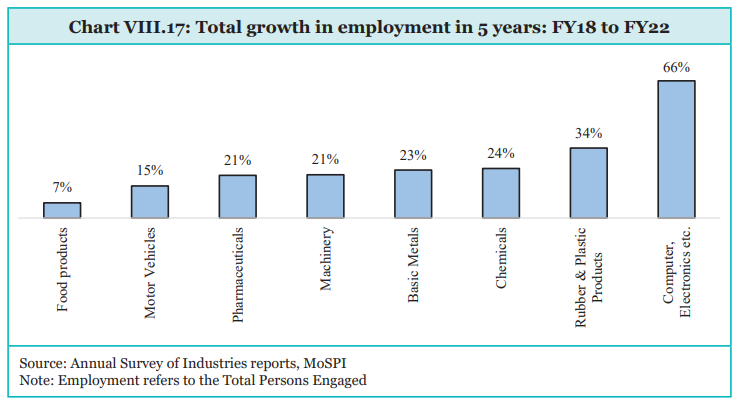
Government initiatives to boost employment generation
To boost employment generation, the government has implemented various measures such as the rollout of the Production Linked Incentive (PLI) scheme to enhance India’s manufacturing capabilities, increase capital expenditure, etc., and to promote worker welfare.
Along with this, there has been a boost to self-employment through the easing of access to credit and multiple process reforms. Some of the schemes to promote both job creation and job creators are as follows:
- National Career Service (NCS) Portal: it was launched in 2015 with the aim of offering employment and career services. By 31 March 2024, it has attracted 4.1 crore jobseekers and 25.6 lakh employers.
- E-Shram portal: It is the first-ever national database of unorganised workers, with more than 29 crore workers registered. It has been integrated with the NCS portal to facilitate job search and to integrate it with other relevant portals to facilitate access to different Central Government schemes for unorganised workers in one place.
- Aatmanirbhar Bharat Rojgar Yojana (ABRY): it was launched in October 2020 to boost employment with social security benefits post-COVID-19 job losses.
- To ensure minimum pension for all workers, the government has launched two significant schemes:
- Atal Pension Yojana (APY): It was launched in 2015 and now has more than 6.5 crore subscribers.
- Pradhan Mantri Shram Yogi Maan-Dhan (PM-SYM) scheme: It was launched in 2019, and currently, more than 50 lakh workers are enrolled in the scheme.
- Affordable insurance programmes: Life and Disability cover is provided through Pradhan Mantri Jeevan Jyoti Bima Yojana (PMJJBY) and Pradhan Mantri Suraksha Bima Yojana (PMSBY) of ₹2 lakh at an annual premium of ₹436 and ₹20 only.
- Social security benefits have been provided to gig and platform workers via a Social Security Fund, financed by contributions from the Central and State Governments, Aggregators, CSR, etc, under new labour codes.
- PM SVANidhi Scheme: it was launched in June 2020 with the aim of facilitating collateral-free working capital loans to street vendors and has more than 64 lakh beneficiaries to its credit.
- One Nation One Ration Card Programme: It was launched in 2019 to facilitate migrant workers’ welfare by allowing portable food security across India.
- Prime Minister’s Employment Generation Programme (PMEGP): it was launched to help entrepreneurs set up new units in the non-farm sector. It aims to provide employment opportunities to traditional artisans/ rural and urban unemployed youth at their doorstep.
- Deendayal Antyodaya Yojana – National Urban Livelihoods Mission: It aims to reduce poverty and vulnerability in urban poor households by enabling them to access self-employment and skilled wage employment opportunities.
- Pradhan Mantri Mudra Yojana (PMMY): it was introduced to facilitate self-employment and to provide collateral-free loans up to ₹10 lakh to micro/small business enterprises and to individuals to enable them to set up or expand their business activities.
- Stand Up India: It was launched on 5 April 2016 with the aim to promote entrepreneurship among the SC/ST and Women by facilitating bank loans of value between ₹10 lakh and ₹1 crore. In FY20, the Stand-Up India Scheme was extended for the entire period coinciding with the 15th Finance Commission period of 2020-25.
- Start-Up India: Government initiatives in simplification and handholding, funding support and incentives and industry-academia partnership and in cubation have led to a significant increase in the number of Department for Promotion of Industry, and Internal Trade (DPIIT) recognised startups from over 300 in 2016 to 1,17,254, as on 31 December 2023.
- Flagship programmes: apart from the above-mentioned initiatives, several flagship programmes of the Government, such as Make in India, Digital India, Smart City Mission, Atal Mission for Rejuvenation and Urban Transformation, Housing for All, Infrastructure Development and Industrial Corridors, are also oriented towards generating employment opportunities.
The government simplifies labour laws by amalgamating 29 laws into four labour codes to promote employment and reduce complexity.
Most states have pre-published the draft rules, but enactment needs to be expedited.
Re-balancing Labour Regulations to promote employment
Current labour regulations have unintended consequences for both the general workforce and women specifically. It intends to protect workers, but it actually restricts employment opportunities and hinders job creation. For examples;
- Strict overtime wage regulations in India drive production to countries with lower costs, hindering the growth of the manufacturing sector.
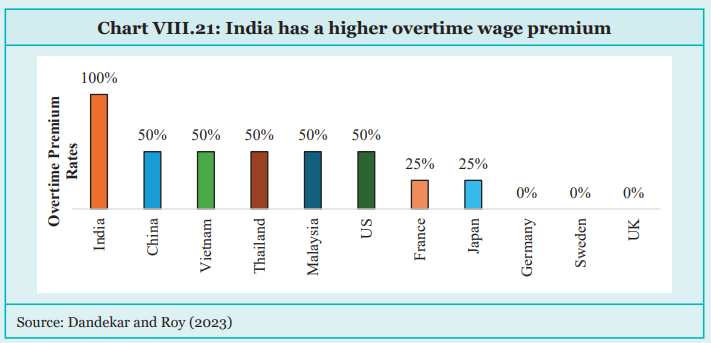
- Prohibition on women from participating in certain factory processes by the ten most populous states.
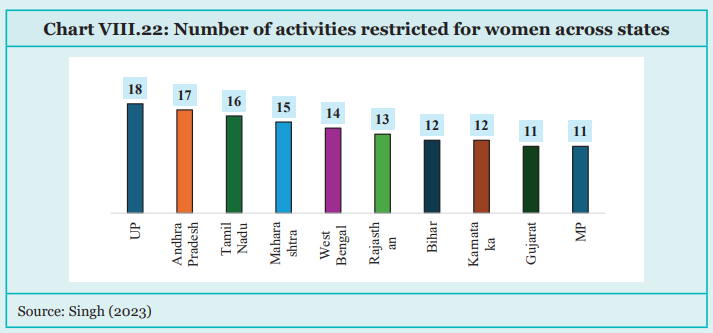
- India prescribes higher floor space per worker on a factory floor compared to other countries. Adopting Malaysia’s standard could add 82 workers per 1000 sqm. These strict rules can limit factory expansion and jobs.

- Inflexibility in working hours as compared to other countries can limit monetisable time for workers.
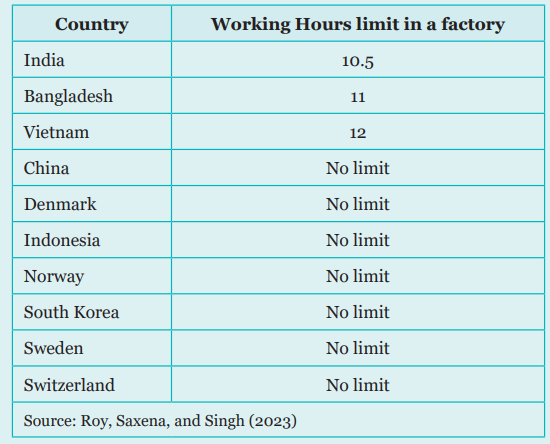
Conclusion:
The new Labour Codes marginally improve some of the observations above, but many states are found to be reintroducing the older restrictions under the new Laws, and also, the Codes are not operational.
Labour Laws need to be reviewed to promote economic growth, prosperity and gender inclusivity. Implementing more flexible labour laws could unlock economic potential, promote gender equality, and attract industrial investment.
THE EVOLVING LANDSCAPE OF JOBS IN INDIA
The economy is transitioning to middle-income status, requiring adaptable human resources to the changed scenario. The global labour market is undergoing disruption due to fourth industrial revolution, decarbonization efforts, geopolitical changes and technological changes have been disruptive, particularly for non-college workers.
According to the world economic forum’s Future of Jobs report, 2023, 23% of jobs is expected to change in the next 5 years, 10.2% job growth, 12.3% job decline, net loss of 14 million jobs (2% of current employment).
The following are some ways in which the work environment is evolving.
Fourth industrial revolution:
- All three Industrial revolutions has caused the technological disruption and significant job displacemt and change in labour markets.
- Each Industrial revolution required workers to adapt and acquire new skills to remain employable.
- The Fourth Industrial Revolution is underway, characterized by Cyber-physical systems, Internet of Things (IoT), Big data, AI, Machine learning.
- This revolution is transforming India’s job market, with Growing demand for digital roles, increasing need for tech-savvy professionals in areas like AI, cybersecurity, and
- According to the World Economic Forum (WEF), the fastest-growing jobs in the next five years will be in AI and machine learning, Sustainability, Business intelligence, Information security and the largest absolute growth is expected in Education, Agriculture and Digital commerce.
Disruptions due to the adoption of AI
- The biggest disruption for the future of work is the accelerated growth in AI, which is poised to revolutionise the global economy with India also impacted.
- As AI adoption increases, the future of work will be reshaped, with boosted productivity, Potential job disruption in certain sectors, Automation of routine tasks (e.g., customer service), AI tools transforming creative sectors (e.g., image and video creation) and personalized AI tutors changing education, Accelerated drug discovery in healthcare.
- Research suggests AI may reshape jobs more than replace them. According to IMF (2023)34 and IMF (2024)35, almost 40 per cent of global employment is exposed to AI, with 60% in advanced economies.
- AI poses both risk and opportunity for India’s young population. The current diffusion and adaptation of AI in India remains low as compared to other countries.
- Manufacturing sector is less exposed to AI, but BPO sector is at risk due to GenAI, uses of AI to identify health risks out of digitalised health data, predict weather, and complementing teachers in grading tests and translating texts are some of the development gaps that AI can plug.
- Demand for AI skills is increasing exponentially, displacing non AI roles and high skilled positions.
- Proactive government and industry interventions can position india as an important AI player. Workers need skills such as analytical thnking, innovation and resilience to adapt to AI.
Making the most of AI in India
- Despite being a global AI leader, India has a significant research gap, with few papers published compared to china and the USA.
- The US has laid a well-defined strategic plan to strengthen its AI sector, with nine steps to address challenges.
- For instance, making long-term investments in AI Research, developing effective methods for human-AI collaboration, understanding and addressing implications of AI , ensuring the safety and security of AI systems, developing datasets for AI training and testing, measuring and evaluating AI systems, better understand national AI R&D workforce needs, expanding private-public partnerships, and establishing a coordinated approach to international collaboration in AI Research.
- India needs an Inter-Agency Coordination Authority for AI to guide research, decision-making, and policy planning.
- AI will create jobs, but may have a negative short-term impact; investing in capacity building, upskilling, and training is necessary to mitigate this.
- AI has made significant growth in various Indian sectors, including agri-tech (e.g., Praman Exchange, using computer vision for quality assessment), Industry & automotive, Healthcare, Retail, etc.
Shift towards gig economy
- In India, the rise of the gig economy is driven by the emergence of tech-enabled platforms, an increase in access to the internet backed by the development of digital public infrastructure.
- According to NITI Aayog’s indicative estimates based on national labour force survey data, in 2020–21, 77 lakh (7.7 million) workers were engaged in the gig economy. They constituted 2.6 per cent of the non-agricultural workforce or 5 per cent of the total workforce in India.
- The gig workforce is expected to expand to 2.35 crore (23.5 million) by 2029–30.
- Gig workers are expected to form 6.7 per cent per cent of the non-agricultural workforce or 4.1 per cent of the total livelihood in India by 2029–30.
Climate change and green energy transition
- Climate change will lead to job losses and productivity decline due to extreme weather events. According to the International Labour Organization (ILO), projections based on a global temperature rise of 1.5°C by the end of the 21st century, with 8% of global working hours projected to be lost by 2030 (136 million jobs).
- India is vulnerable due to its agricultural and construction sectors and tropical location.
- Transitioning to greener energy alternatives and energy alternatives will create new job opportunities.
- India’s green transition is and is more likely to significantly impact job opportunities in the renewable energy sector.
- India’s renewable energy sector can potentially create 3.4 million jobs by 2030.
- Climate change affects worker well-being, requiring policy support and insurance products to protect health and incomes.
- Adapting to change, encouraging innovation, and careful planning can mitigate negative impacts on the job market.
REQUIREMENT OF JOB CREATION UNTIL 2036
- Indian economy needs to generate an average of nearly 78.5 lakh jobs annually until 2030 in the non-farm sector to cater to the rising workforce.
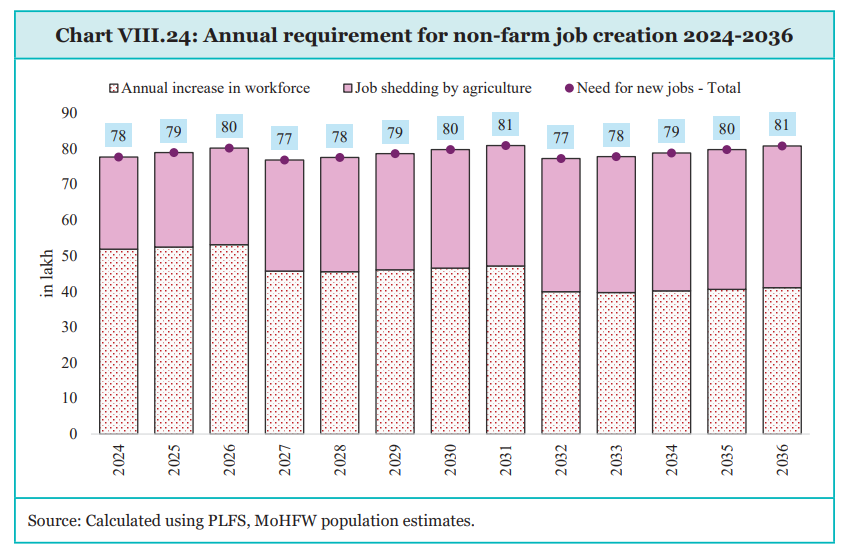
- There is scope to supplement the existing schemes of PLI (60 lakh employment generation over 5 years), 61 MITRA Textile scheme (20 lakh employment generation), 62 MUDRA, etc to meet the demand of 78.5 lakh jobs in non-farm sector per year.
AGRO-PROCESSING AS A PROMISING SECTOR FOR RURAL EMPLOYMENT AND GROWTH
As agro processing sector lies at the centre, it can create jobs and drive rural growth, leveraging India’s agricultural sector. The following paras elaborate on the suitability of agro-processing for job creation:
- Demand for rural jobs: MGNREGS data shows demand for low skill rural job, especially among women. Given that agriculture and related industries remain the mainstay of the rural economy, Agro-processing can increase productivity, accelerate crop diversification, and reduce fiscal strain.
- Low value-addition in agriculture: India’s agricultural sector has low value-addition, with only 4.5% of fruits and 2.7% of vegetables processed. In contrast, China processes 30% of its food, while Western countries process 60-80%.
- Rising demand for diverse and local food products: There is rising demand for diverse and local food products, with the Indian food processing market expected to reach USD 535 billion by 2025.
- Presence of precedents: There are many Success stories like Sahyadri Farmer Producer Company and Araku Coffee plantations (Andhra Pradesh) demonstrate the potential for bottom-up agro-processing approaches.
- Avenues for captive demand of agro-processed output: The local units can supply the Aanganwadis, mid-day meal in schools, urban consumers with rising health consciousness, Specialised products could be linked to export supply chains.
- Convergence of existing programmes: it can benefit the Mega Food Park, Skill India, Mudra, one district-one product, etc., for labour, logistics, credit, and marketing. Such convergence of efforts would immensely benefit from a whole-of-government approach involving gram panchayat, block, and district administration. Organisations such as NABARD, Central Warehouse Corporation, Krishi Vigyan Kendra, etc.
Thus, India can utilize its agricultural strengths and engage its rural wokforce, including women and educted youth, in agro processing.
CARING OUR WAY TO GROWTH: THE NECESSITY AND PROSPECTS OF A WELL-DEVELOPED CARE ECONOMY IN INDIA
The care economy is a crucial sector for India’s economic growth and well-being, particularly given its young population and gender demographics. Developing a quality care sector can promote gender equality, human development, and economic growth.
According to ILO, Care work consists of activities and relations involved in meeting the physical, psychological, and emotional needs of adults and children, old and young, frail and able-bodied.
Care work falls into two categories:
- unpaid/underpaid: Unpaid or underpaid work related to caregiving and providing social support is often performed within households by females and usually consists of childcare, eldercare, domestic work, etc.
- Compensated: Paid care work involves labour performed by nurses, caregivers, etc., for remuneration.
Increasing need for a well-developed care economy:
- Demographic transition need to prepare for future care requirements of an ageing population as by 2050, the number of people requiring care will increase from 50.7 (2022) crore to 64.7 crore.
- Women bear a disproportionate burden of unpaid care work, limiting employment opportunities this burden leads to reduction on women’s labour market participation by 20%. The working age women in India spend 5.6 hours per day on unpaid work, whereas the 30 minutes per day for men.
- This unpaid/invisible domestic work performed by women, which is usually neglected while calculating the labour force and the GDP, has been variously estimated as highly valuable yet invisible.
- According to ILO (2018), the care sector is one of the fastest-growing sectors globally, and investments in the care services sector are estimated to generate 475 million jobs globally by 2030.
- In the case of India, direct public investment equivalent to 2 per cent of GDP has the potential to generate 11 million jobs, nearly 70 per cent of which will go to women.
Senior care reforms in India: Reimagining the senior care paradigm
The old-age dependency ratio is expected to rise from less than 20 per cent in 2022 to over 30 per cent by 2050 according to the Asian Development Bank’s (ADB) ‘Ageing Well in Asia’ report.
The care responsibility related with an increasing older population requires early dialogues around senior care to develop a future-ready elderly care policy.
The rising need for elderly care:
The India Ageing Report 2023, by UNFPA and the International Institute for Population Sciences highlights that a significant portion of the elderly population suffers from chronic diseases, functional limitations, depressive symptoms, and low life satisfaction. The recommendations of the report are as follows:
- Including relevant questions in the National Sample Survey, the National Family Health Survey, and the Census of India to inform evidence-based policymaking.
- Increasing awareness about existing schemes for older persons, bringing all Old Age Homes under regulatory purview, and encouraging the creation and running of elderly self-help groups.
- Emphasising the importance of elderly people living in multigenerational households. Encourage policies that facilitate and support this living arrangement.
- Encouraging in situ (at home) ageing as much as possible by creating short-term care facilities like creches or day-care facilities
India needs a structured elderly care policy framework, to fill gap in infrastructure, research, and know-how for geriatric illness management, monitoring mechanisms and emergency response systems
CONCLUSION AND WAY FORWARD
The employment situation in India has experienced Positive transformation over the last decade, with achievements in formalization, skill development, entrepreneurship, industry diversification, and inclusive growth.
Nevertheless, there remain long-existing challenges of formalising a burgeoning workforce, job creation in sectors absorbing workers from agriculture, social security benefits for regular wage/salaried employees.
The agro-processing sector lies at the overlap of India’s requirements of productive, intermediate, and large-scale job creation for rural youth and women, with rich dividends to reap from the convergence of schemes and a mission-mode unwavering focus at a national scale.
The employment landscape is fast changing worldwide, and India, aspiring to be a developed nation by 2047, must partake in the massive reshaping of jobs that AI has and is likely to further spin off. India thus needs to invest in research and steer the AI bandwagon towards shared prosperity.
At the same time, something as basic and age-old as unpaid care work needs our attention too. The development of an affordable, reliable, and quality creche and elderly care infrastructure is the Achilles heel for female participation in paid work, which should be determined by comparative advantage and choice rather than dictated by gender.


